4 Sarah Crumrine on Johannes Itten
Sarah Crumrine studies Environmental Science and Resource Management and is part of the University Interdisciplinary Honors program. She is interested in natural resource conservation and the complex issues of how humans relate to and are supported by ecosystems. Additionally she is a maker; using sewing and practical craft forms for creative expression.
Johannes Itten (1888–1967) was a Swiss painter. He was an elementary school art teacher before joining the Bauhaus as a Master of Form; he developed the preliminary course which selected and instructed all students.
Introduction
To bring insight to students who wish to follow the lessons of Johannes Itten, I will explore his movement and spiritual practices to find their merits and meaning. The connection between body and mind is key to Itten’s theory that breath, movement, and diet can purify the body and facilitate new artistic discoveries in color and form, yet the underlying belief is suspect. Inspired by Itten’s color exercises, I developed an experiment of my own to reflect upon what can be gained through the linking of movement and making, and I present how an improved version of Itten’s process of making could benefit students alike.
Part I. The Theory and Background of Movement and Making
Itten’s Influence on the Bauhaus
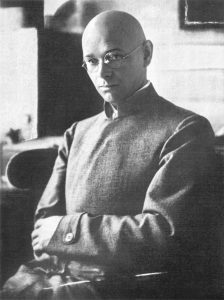
Teaching across multiple workshops, the painter Johannes Itten introduced bodily movement practices rooted in Mazdaznan spirituality to his teaching[1]. Course topics included form and color, along with Mazdaznan rhythmic exercises, breathing patterns, and meditation.
Students participated in activities to coordinate artistic movement with physical movement for “the cultivation of a healthy rhythm”[2]. Rhythmic drawing and breathing were practiced to provide consciousness, life, and health, in contrast with irregular, arrhythmic movements that could harm as severely as death[3]. Itten linked invisible mental function with outward physical signs, and that concept appears in more and more modern health and exercise practices.
Itten’s goal to engage the body physically before creating art aimed to strengthen spiritual connections; his influence was described as creative liberation by some and brainwashing by others. Ultimately, students emerged with a common vocabulary in color and form, armed with a tool kit of routines to get their creative juices flowing. On a surface level, no part of this seems harmful, and yet I am critical of the Mazdaznan belief and overly-strict routines.
I wonder if Itten and those who promote strict regimes today may have an outsized influence due to the importance we place on ‘expert training’. The general public is eager to learn about the behaviors, beliefs, or systems that exist in that ‘successful’ person’s life to guide them to fame and mastery, because then we can consider what they provide for the practitioner and if they would give us the same effect. But in the case of Itten, the roots of Mazdaznan inspire racism and genocide, so his practices must be approached with caution. Likewise, modern wellness practices can have a harmful side when taken to an extreme.
Criticism of Spiritual and Wellness Regimes
For as much good as movement and spirituality can bring to the arts, it is entirely possible for wellness efforts to go too far. In the case of Mazdaznan, early literature expresses ideas of racial superiority and anti-Semitism. For an individual to be considered ‘clean’, an example of what is ‘dirty’ must exist. German research historian Ulrich Linse identifies the danger of the cleansing as that “Mazdaznan self-reform always had racial refinement as a larger goal”[4]. When the point of the movement is no longer just to improve the individual, but rather shift society toward one side and flatten out any spikes of diversity, a toxic system has been created.
There are dark sides to both Itten’s inclusion of physical and spiritual practices in his teaching, just as modern health and wellness movements have their own pitfalls. Both can have unfortunate intentions; the Mazdaznan philosophy on which Itten based his techniques sought to achieve a purer, whiter race, while modern health and diet movements can present unattainable ideals and mask restrictive or obsessive habits. In my own experience of dance, an emphasis on thin, white bodies is harmful in a similar way to Mazdaznan doctrines that excluded Jews and darker skinned people in pursuit of purity.
I think that the similarity between these two issues is an overemphasis on cleanliness with detrimental effects of obsession and categorization. The obsession gives the practitioner a sense that their controlling view is the only way to see the world. And the categorization casts the food, bodily movements, and mindsets of the world in two types: good and bad without accounting for context or emotional aspects of the choices people make. This can lead to attack on the self or others, and lead to harm—not creativity. I am unsure why Itten would have been so drawn to this ideal of cleanliness if it washes away the variety of the world that supports creativity.
My Own Relation to Movement Practices
I see the effect of breath and movement on the creative mind as a soothing of anxiety and preparation for deeper thinking. Modern society promotes a lack of awareness of where the body is in the world and how the body can calm the mind and vice versa. Focusing on such a simple thing as breath can help a person refocus and set an intention that will channel their energy into the task at hand. Likewise, feeling how the muscles and bones of the body can flow opens up the possibilities for the actions they can take, which is directly tied to the physical action of making art. In these two ways, it is logical for breath and movement to be warm-up activities in art education. My personal connection to warm-up activities is in classical ballet, where rhythmic and repetitive movement eased me into creative expression, but I will now reflect on other ways I have incorporated movement into my making.
Examples of My Own Art Education & Making Practices
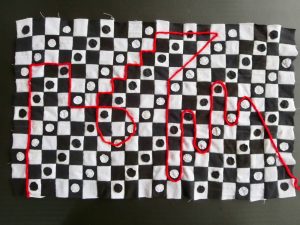
Over the course of the past 9 weeks, I have considered movement in relation to my own making to an increasing degree. The idea for my textile project came to me while running; I was breathing hard in sync with the beat of my feet hitting the trails. The idea that I developed reflected that rhythm and energy that I was feeling, and this mood was also present in the
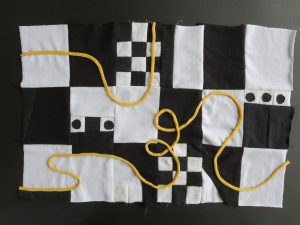
making process itself. Over and over I sewed squares to squares to squares and then many circles on top, the patterns and motions of cutting, sewing, pressing not unlike an exercise regime. I felt a benefit from movement in both the ideation and actualization of my project that is visible in the final pieces. Atop patterned backgrounds that convey structure and regime, there are meandering lines of color that suggest freely moving forward. The dual nature of waiting being something that I want to be over as quickly as possible, but also make use of is accompanied by a duality between movement being for the physical health and emotional or mental wellbeing.
In a class discussion, my peers identified the needle as an actor engaging in rhythmic and repetitive motions between cloth and thread[5].
This contributes to the overall feeling that sewing is meditative; it is a very physically-involved making practice that demands full attention from the mind to execute the creative plan. Little space is left in the mind for doubt or nervousness or apprehension because the process is immersive. Austin Kennedy writes on the role of rhythm in the work of Karen Karnes, see his chapter for a brief mention of rhythmic maker practices.
In this way, hand sewing becomes a practice that is more than just production of a textile, similar to how Itten’s lessons went beyond the mathematical combination of pigments to achieve certain colors. When the making practice becomes a full body experience, other makers are invited to join in. We see this in historical traditions of quilting; from quilting bees of the 1800s to small gatherings in the 1980s to assemble the NAMES Project AIDS Memorial Quilt[6]. People form community when they engage with the meditative practice of making and are better able to value their own creative ideas and those of others, ultimately resulting in deeper artistic practice. And whether alone or in groups, the movement itself adds another aspect to the final creation.
In contrast, increasingly digitized forms of art are reducing the hands-on nature of crafts like ceramics and sculpture. Instead they replace the muscle with the algorithm, allowing advantages like “rapid, incremental, reversible, physical actions on the object; and immediately visible results”[7] which arguably make art more accessible so long as the artist has a computer and the requisite software. What comes of this making in the absence of movement is not static, lifeless art, which supports an argument that it is not the physical movement of the body making art that gives it dynamic qualities (as I suggested in relation to my textile project). Instead, digital craft demands movement of the mind and the execution of rhythmic computing; digital design specialist McCullough describes the character of this mental movement: “you become able to execute tightly synchronized combinations…you may feel some intellectual agility…the habit of identifying patterns.”[8]. In conclusion, the physical touch and awareness of traditional craft cannot be simulated and thus will endure in the world of making.
Part II. An Experiment of Movement and Making
Itten’s Color and Form Exercises
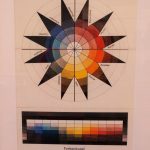
Starting with finding the harmonies and contrasts in color duos, Itten adds more colors and more shades into his lessons, until he reaches the twelve-pointed color wheel. His method used pieces of colored paper, paint pigments, or colored threads to calibrate the eyes, to improve perception of color, and perfect the artist’s ability to compose and pair colors[9].
Personal Experiment in Itten’s Exercises
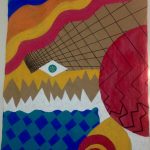
My relation to color is that I love it! Surrounded by bright, contrasting posters, I have several ‘test’ paintings hanging in my room. Though I want to try new combinations, I don’t want to make a mistake, so I am hesitant to try out new combinations on nice paper, because I don’t want to ruin it. And yet, I love how my ‘tests’ come out, so I challenge myself to make experimentation part of the real process instead of a preparation piece that doesn’t get exposed.
Over the course of three days, I will be conducting an experiment to test the benefit of various exercises performed before doing Itten’s color exercises drawn from a shortened, English version of the artist’s text The Elements of Color. I will do 20 to 30 minutes of activity: walking, running, and Pilates, performing the color exercise in a digital painting app immediately afterwards until I notice some interesting phenomena.
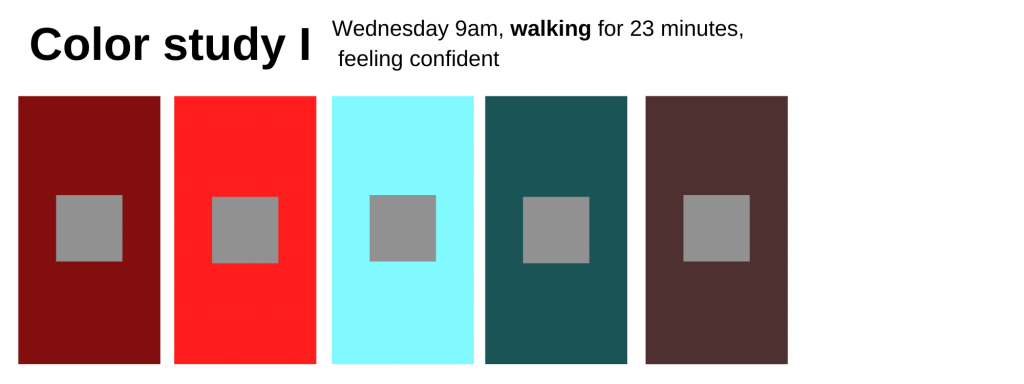
Inspired by the gray exercise[10], I created 5 different colored panels with the same gray square in the center of each one, to study how the surrounding color changed the appearance of the gray. I chose two reds and two blues, with a lighter and darker version of each, and then one blend of the darker red and darker blue. I saw how on the brighter backgrounds (second and third from left) the gray appeared darker, while on three darker colors, the gray square appears lighter in comparison to the same gray on the corresponding brighter background. Itten’s analysis of this exercise references ‘simultaneous contrast’ which suggests that the gray “seems tinged with its complementary” because our eyes prefer to perceive a contrasting relationship[11].
Another visual effect I noticed were the gray squares’ perceived depth; on the brighter colors, the squares floated, while on the darker backgrounds, they receded and seemed to be cut-outs to a lighter background. This exercise was a joy to start off with.
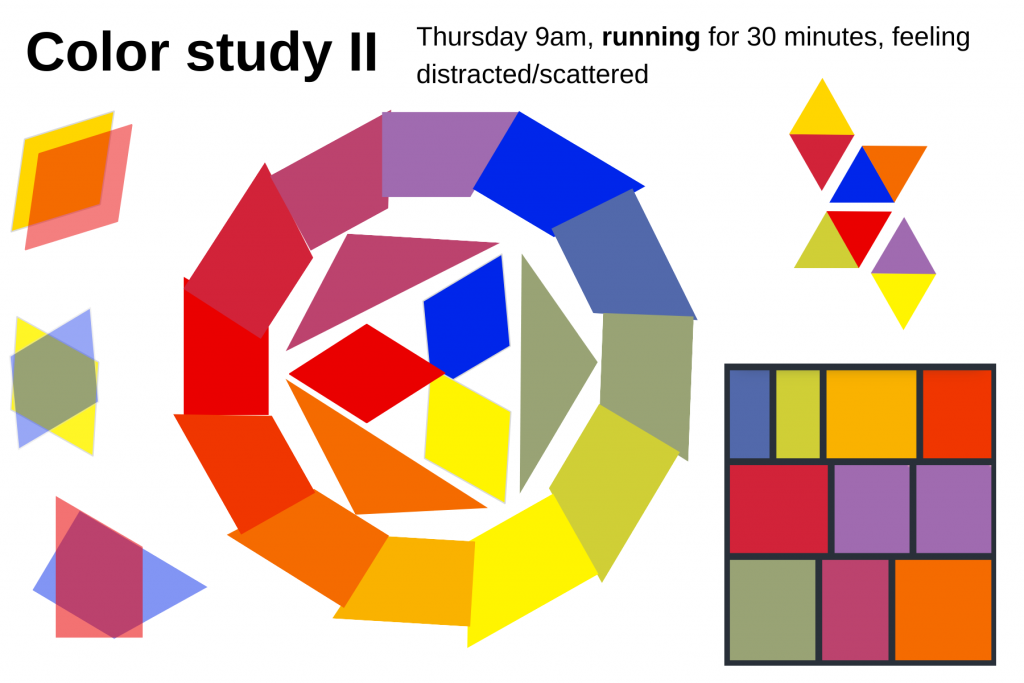
Next I tried making a color wheel. My results were rings of well-coordinated secondary and tertiary colors derived from the center trio, however the relationship between the outer twelve and inner trio was lacking. This was probably due to my mixing method—by stacking transparent polygons and screenshotting the result—making all derived colors more muted and gray. I thought that because of this change, the tertiary colors then paired better with themselves and especially on a dark background (as shown in the bottom right) but I did try pairing a tertiary purple with a primary yellow (upper right). My largest struggle was combining the blue and yellow into green. Just as Itten says it’s “no easy task to obtain secondaries by mixture”[12], I noticed that the composite of blue and yellow was less vibrant than either of its parts alone.
To call my digital art ‘mixing’ is inaccurate though; digital art is fundamentally different from what Itten was doing in the 1930s with a finite selection of paint pigments. When I use my digital painting app, I choose from an infinite number of mixtures, so the entire process is free from constraints from the start, and increased levels of mixing or derivation don’t correspond with increasing levels of freedom the way they do in traditional paints. Thus digital art has immeasurably more freedom from the start. To skim over this chasm, we simply summarize this activity as one demonstrating how colors pair well together when they have been blended in similar ways.
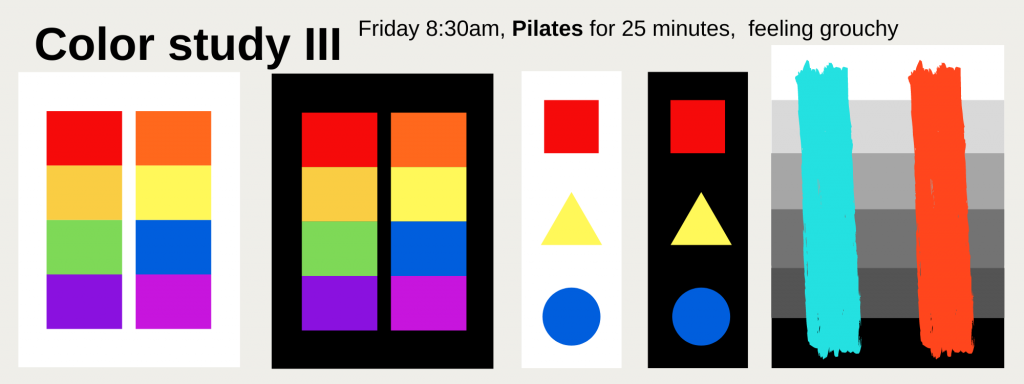
I finished by exploring contrasts; I made comparisons between the same colors on black and white backgrounds and observed how the colors seemed to change in size in depth. First, I made twin octa-color palettes and observed how against black, the same sized squares looked larger and the black border shrank. Depth was also affected; in the middle pair of contrasts the yellow triangle on black jumps out and blue moves back; on white it is the reverse. I was pleased with this effect, as it follows the theory outlined by Itten [13] and my Color Study I where lighter shapes rise to the foreground. Finally, with a background of shades of gray, I tested Itten’s theory that “among cold and warm tones of equal brilliance, the warm will advance and the cold retreat”[14], and observed the red-orange stand out particularly against the darker background. Additionally, I saw that within each bar of gray, the top edge appeared darker while the bottom edge of the same panel was faded. This was a surprising phenomenon that in between two comparisons–to one shade lighter and one shade darker–the same color will change so that it contrasts more strongly with either closer neighbor. I was fascinated by this dynamic behavior by something so passive as gray.
Results
Movement helped! I lacked a no-treatment control to see if simply the act of practicing color exercises improved my feelings towards them, but I can conclude that there was no negative effect to combining various forms of movement with making. As I’ve said before, some of my best ideas have come to me while running; it’s the perfect storm of slight distraction of the body to allow the mind to wander, plus immersion in natural or urban surroundings full of inspiration and wonder. In this experiment when I went out for my exercise, I tried to notice the colors and contrasts of nature to bring back to my color study. For example, the sight of purple-red flowers on dark green heather shrubs informed my mixing of tertiary colors in Color Study II.
Part III. Lessons For The Path Forward
One lesson for art education from this experiment and analysis of my other art projects is that a dedicated physical routine develops the art further, because movement helps prepare the mind and body. Movement practices before or within the craft can add additional meaning to the final product. Movement can be a preparation for the making, and it can be intrinsic to the making itself. The experience of sewing being meditative and rhythmic in a way that helped further develop the meaning of the piece was felt by me and my classmates both.
The specific benefit of rhythmic bodily movement is the heightened awareness it brings; deeper concentration is facilitated by intentional breathing, stretching, or aerobic practices. As I stated in my introduction, movement breaks down hesitations to create because it links the mind and body subconsciously, so that the hand can execute what the unconscious mind sees without the conscious mind stepping in with excuses.
Current literature echoes this; the media reports the findings of various psychological studies with results connecting regular exercise with lessened depression[15][16], and some online sources even provide guidance specifically tailored to artists. The basis for these findings is not spiritual, it’s in the biochemistry of the brain. My discovery that moving my body gives me freedom to find new ideas is similarly expressed by a painter quoted saying “when I run, I can step out of the mind and watch the thoughts…I can watch the film of my own thoughts [which] creates a relationship of sequence, and I can get very clear on ideas and possibilities”[17]. Another discovery of mine that bodily movement regimes build routine to prepare for art practices is echoed by artists interviewed, who say that exercise structures their time.
The lesson from Itten’s overall story of strict diet, cleansing practices, and spirituality is that purity can be misinterpreted in dangerous ways. Though Itten appears to be free of connection to Nazism, talking about his art pedagogy being based on Mazdaznan still brings attention to a religious movement with a harmful past and invokes questions of how much a teacher’s personal beliefs should be expressed to their students. In Sommer Ullrich’s chapter on Itten, she states “teaching should not involve the teacher’s personal religion”, and I agree with that in cases where the teacher’s religion is separate from the subject matter they signed up to study.
Misinterpretation of purity exists in modern life, where strict habits consume broader joys, or limited acceptance of body types outside the norm of thin, white, athletic prevent many from participating in dance or fitness.
Movement and spirituality have the potential to help or harm, depending on how strictly they are pursued. Variety is as necessary to a maker’s life as routines that carve out time for dedicated experimentation in the colors, forms, and material of making. I would not change Itten’s lessons, but future art educators or student makers should only follow his teaching with the caveat of ‘everything in moderation’.
Media Attributions
- Johannes Itten © Paula Stockmar is licensed under a CC BY-NC-SA (Attribution NonCommercial ShareAlike) license
- Red thread © Sarah Crumrine is licensed under a CC BY-NC-ND (Attribution NonCommercial NoDerivatives) license
- Yellow thread © Sarah Crumrine is licensed under a CC BY-NC-ND (Attribution NonCommercial NoDerivatives) license
- Johannes Itten, Kleurenleer, paint © moedermens is licensed under a CC BY (Attribution) license
- Wall Painting © Sarah Crumrine is licensed under a CC BY-NC-ND (Attribution NonCommercial NoDerivatives) license
- Color Study I © Sarah Crumrine is licensed under a CC BY-NC-ND (Attribution NonCommercial NoDerivatives) license
- Color Study II © Sarah Crumrine is licensed under a CC BY-NC-ND (Attribution NonCommercial NoDerivatives) license
- Color Study III © Sarah Crumrine is licensed under a CC BY-NC-ND (Attribution NonCommercial NoDerivatives) license
- Moore, Padraic E. “A Mystic Milieu.” bauhaus imaginista, 2018. Accessed March 1, 2021 http://www.bauhaus-imaginista.org/articles/2210/a-mystic-milieu. ↵
- Burchert, Linn. "The Spiritual Enhancement of the Body: Johannes Itten, Gertrud Grunow, and Mazdaznan at the Early Bauhaus." In Bauhaus Bodies: Gender, Sexuality, and Body Culture in Modernism’s Legendary Art School, edited by Elizabeth Otto and Patrick Rössler, 49–72. Visual Cultures and German Contexts. New York: Bloomsbury Visual Arts, 2019. Accessed March 1, 2021. http://dx.doi.org.offcampus.lib.washington.edu/10.5040/9781501344817.ch-003.p. 50. ↵
- Burchert, 51 ↵
- Linse, Ulrich. “Johannes Itten and the Bauhaus”. Bauhaus imanginista, Accessed March 1, 2021 http://www.bauhaus-imaginista.org/articles/4787/johannes-itten-and-mazdaznan-at-the-bauhaus ↵
- UW Students. “HON211 Needle.docx” Accessed March 7, 2021 ↵
- Bryan-Wilson, Julia, Fray: Art and Textile Politics. University of Chicago Press, 2017. ↵
- McCullough, Malcolm. Abstracting Craft: The Practiced Digital Hand. Cambridge, MA: MIT Press, 1997, pp. 312. ↵
- McCullough, pp. 314. ↵
- Itten, Johannes. The Elements of Color. Edited by Faber Birren. New York, NY: John Wiley & Sons, 1970. p. 65. ↵
- Itten, 20. ↵
- Itten, 19. ↵
- Itten, 29. ↵
- Itten, 77. ↵
- Itten, 78. ↵
- Fields, Jonathan, “The Creative Brain on Exercise”. Fast Company, Sept. 29, 2011. Accessed March 2, 2021 https://www.fastcompany.com/1783263/creative-brain-exercise ↵
- Loria, Kevin. “Exercise might be more than good for your brain — it could make you more creative as well”. Business Insider, Nov. 4, 2016. Accessed March 2, 2021 https://www.businessinsider.com/exercise-benefits-brain-creativity-stress-2016-11. ↵
- Kunitz, Daniel, “Why Exercise Makes You More Creative”. Artsy, Nov. 24, 2017. Accessed March 2, 2021 https://www.artsy.net/article/artsy-editorial-exercise-creative. ↵

